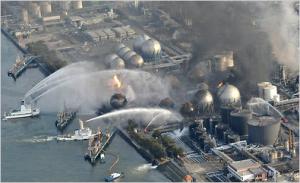Nuclear accidentsFukushima five years on: Three lessons from the disaster
It has been five years since the emergency sirens sounded at Japan’s Fukushima Daiichi power plant following the massive 2011 earthquake and subsequent devastating tsunami. The partial meltdown of three reactors caused approximately 170,000 refugees to be displaced from their homes, and radiation releases and public outcry forced the Japanese government to temporarily shut down all of their nuclear power plants. On the fifth anniversary of the partial meltdown at Japan’s Fukushima Daiichi Power Plant, Stanford’s Rodney Ewing says we should rethink our language, reassess natural disaster risks, and appreciate the links between nuclear energy and renewables.

Fireboats attempting to cool the site prior to containment and repair operations // Source: suffolk.edu
It has been five years since the emergency sirens sounded at Japan’s Fukushima Daiichi power plant following the massive 2011 earthquake and subsequent devastating tsunami. The partial meltdown of three reactors caused approximately 170,000 refugees to be displaced from their homes, and radiation releases and public outcry forced the Japanese government to temporarily shut down all of their nuclear power plants. The events at Fukushima Daiichi sent waves not only through Japan but also throughout the international nuclear industry. Rodney Ewing, an expert on nuclear materials, outlines three key lessons to be taken from the tragedy at Fukushima.
Lesson One: Avoid characterizing the Fukushima tragedy as an “accident”
One of the biggest lessons to be learned from Fukushima Daiichi revolves around the language used to describe nuclear disasters. In the media and in scientific papers, the event was frequently described as an accident, but this does not properly capture the cause of the event, which was a failure of the safety analysis.
As an example, Ewing points specifically to the domino chain of events that led to the partial meltdown at reactors 1 and 3. Following the powerful magnitude 9.0 earthquake, the power plant automatically shut down its reactors, as designed. Emergency generators immediately started in order to maintain circulation of coolant over the nuclear fuel, a critical process to avoid heating and eventual meltdown. But the tsunami that followed flooded the diesel engines that were supplying power, and so cooling could no longer be maintained.
“The Japanese people and government were certainly well acquainted with the possibility of tsunamis,” said Ewing, the Frank Stanton Professor in Nuclear Security and senior fellow at the Center for International Security and Cooperation in the Freeman Spogli Institute. “Communities had alert systems. But somehow, this risk didn’t manifest itself in the preparation and protection of the backup power for the Fukushima reactors. The backup power systems, the diesel generators for reactors 1 through 5, were low along the coast where they were flooded and failed. They could have been located farther back and higher, like they were at reactor 6. These were clearly failures in design, not an accident.
